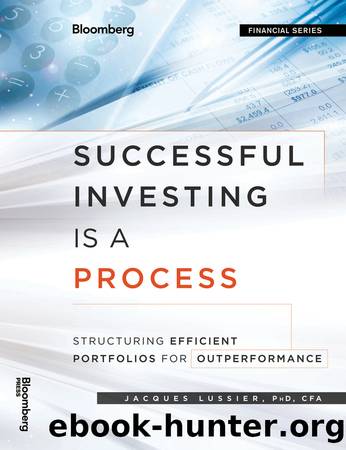Successful Investing Is a Process by Jacques Lussier

Author:Jacques Lussier
Language: eng
Format: epub
Publisher: Wiley
Published: 2012-07-12T16:00:00+00:00
The Bridgewater Approach
An argument could be made that although the size of the risk premium varies among asset classes, most asset classes should yield similar excess returns, adjusted for risk and liquidity over long horizons. Rational investors should require similar risk premiums per unit of risk on average. The assumption that absolute returns are not easily predictable and that the most reasonable expectation is for asset classes to yield similar risk-adjusted excess returns in the long term are the basic principles behind the All Weather product designed by Bridgewater Associates.
The objective of the All Weather program is also to deal with the traditional overconcentration of portfolio risk related to equity exposure. Whether we will agree or not that the All Weather concept offers all the qualities we should seek in an efficient portfolio, the underlying principles on which the product is built addresses many of the issues that we have discussed so far, such as overconcentration of risk in equities and the need to create a statistically more efficient diversification of risk premiums.
Bridgewater started with the principle that there are three sources of portfolio returns: the risk-free rate, the risk premiums that are being offered for taking Beta (market) risks and the Alpha generated by managers. However, although Bridgewater also manages a very well designed Alpha product (one of the few products that may be built around a true Alpha platform and does not offer Beta risks dressed as Alpha), they agree that, on an aggregate basis, Alpha is a zero-sum game, and that only Beta offers a relative certainty of generating excess returns in the long run.
According to Ray Dalio, the founder of Bridgewater Associates (2005) [11], there are fundamental issues with the process of building Beta portfolios. First, although there are many sources of Beta risks (global equities, nominal bonds, inflation-linked bonds, corporate spreads, emerging market spreads, real estate, private equities, commodities, etc.) Dalio argued that the Sharpe ratio of most of these asset classes is relatively low (0.2 to 0.3), while the volatility of some of these asset classes is fairly high. Thus, an investor who seeks a riskier portfolio has no other choice, within the traditional portfolio management context, but to allocate significantly to riskier asset classes such as equities. Therefore, the investor who seeks higher returns will end up with an overconcentration of his or her total portfolio risk in equities and private equities, and his or her portfolio will be anything but diversified.
Figure 7.3a illustrates the traditional relationship between return and risk. The graph is inspired by the work of Rocaton for Bridgewater (2005) [12], and although the data is dated, it is used for the purpose of illustrating Dalio's argument. According to this graph, commodities are not considered an efficient asset class. However, as we have seen in the first section of this chapter, an asset with a lower expected return (and, thus, a lower expected risk premium) can still benefit a portfolio through the rebalancing process.
Figure 7.3a Expected Returns and Risk for Various Asset Classes.
Download
This site does not store any files on its server. We only index and link to content provided by other sites. Please contact the content providers to delete copyright contents if any and email us, we'll remove relevant links or contents immediately.
| Analysis & Strategy | Bonds |
| Commodities | Derivatives |
| Futures | Introduction |
| Mutual Funds | Online Trading |
| Options | Portfolio Management |
| Real Estate | Stocks |
Rich Dad Poor Dad by Robert T. Kiyosaki(6398)
Pioneering Portfolio Management by David F. Swensen(6226)
How To Win Friends and Influence People by Dale Carnegie(4441)
The Money Culture by Michael Lewis(4073)
The Dhandho Investor by Mohnish Pabrai(3698)
The Wisdom of Finance by Mihir Desai(3649)
Liar's Poker by Michael Lewis(3367)
Fooled by Randomness: The Hidden Role of Chance in Life and in the Markets by Nassim Nicholas Taleb(3043)
The ONE Thing by Gary Keller(3007)
The Intelligent Investor by Benjamin Graham Jason Zweig(2995)
Mastering Bitcoin: Programming the Open Blockchain by Andreas M. Antonopoulos(2980)
How to Day Trade for a Living: Tools, Tactics, Money Management, Discipline and Trading Psychology by Andrew Aziz(2909)
Rich Dad Poor Dad: What The Rich Teach Their Kids About Money - That The Poor And Middle Class Do Not! by Robert T. Kiyosaki(2907)
Investing For Dummies by Eric Tyson(2893)
How to Win Friends and Influence People by Dale Carnegie(2860)
Market Wizards by Jack D. Schwager(2643)
Zero Hour by Harry S. Dent Jr. & Andrew Pancholi(2614)
How to Pay Zero Taxes, 2018 by Jeff A. Schnepper(2591)
The Psychology of Money by Morgan Housel(2590)
